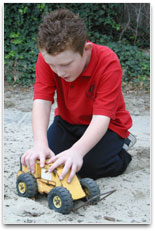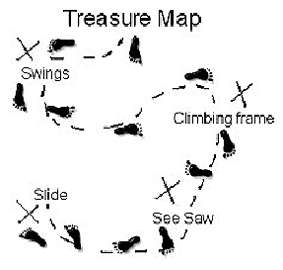This focus idea is explored through:
Contrasting student and scientific views
Student everyday experiences
 An important aspect of young students’ early understandings is that they tend to associate pushes and pulls with living things and to a lesser extent with mechanical machines that cause motion, such as cars pulling boats or bulldozers pushing piles of soil.
An important aspect of young students’ early understandings is that they tend to associate pushes and pulls with living things and to a lesser extent with mechanical machines that cause motion, such as cars pulling boats or bulldozers pushing piles of soil.
Students see things as either moving or not moving. They don’t tend to see motion in terms of different categories such as ‘at rest’, ‘speeding up’, ‘slowing down’, ‘travelling at a constant speed’ or ‘changing direction.’
Students regard non-living objects and living things at rest as being in a natural state where no pushes and pulls are acting on them. This viewpoint may not be substantially changed until at least Level 4 or 5, and may still be present in the senior secondary years. Objects, particularly living things, are seen to experience pushes and pulls only when they move; importantly, these pushes and pulls are seen as necessary to keep these objects moving.
Research:
Driver, Squires, Rushworth & Wood-Robinson (1994) ,
Gunstone & Watts (1985), Osborne & Freyberg (1985), Osborne (1980)
Scientific view
Pushes and pulls are forces, the only difference being that they act in opposite directions. Pushes and pulls can act on, and can be exerted equally well by both living and non-living objects.
For stationary objects and objects moving with unchanging speed and direction, all the pushes and pulls balance each other, i.e. they all cancel each other out. The total effect of all the pushes and pulls is the same as if there were no forces acting on the object.
Critical teaching ideas
- We can describe how something moves by saying how fast it is going and what sort of path it takes.
- The way to start an object moving or change how it is moving is to give it a push or a pull.
- The shape of things can be changed by pushes and pulls. Sometimes these changes in shape are permanent.
 Explore the relationships between ideas about pushes and pulls in the
Concept Development Maps - (Laws of Motion, Gravity)
Explore the relationships between ideas about pushes and pulls in the
Concept Development Maps - (Laws of Motion, Gravity)
Students need to realise that things move in different ways, and that we can describe their speed and paths using words like ‘fast’, ‘getting faster’, ‘straight line’, ‘up and down’, ‘zig-zag’ and so on.
At this level it is appropriate to encourage students to use the terms ‘push’ and ‘pull’ for a range of situations in which things are moving or not moving, and where the direction or speed of movement is changing. They need experiences that help them understand that to change how something is moving it needs to be given a push or a pull.
Their everyday experiences of pushes and pulls such as shaping clay and plasticine or kicking a bean bag need to be explicitly discussed so that students are aware that another effect of pushes and pulls is that they can change the shape of things.
Choose contexts for discussion that assist students to move towards understanding that pushes and pulls act on both non-living and living things.
Teaching activities
Promote reflection on and clarification of existing ideas
Students should be encouraged to observe many kinds of objects moving in diverse ways with the purpose of identifying how the movement is different in each case. Recall that most students just see objects as ‘moving’ or ‘not moving’ without seeing the detail of how the movement of two objects may be different from each other. Ask the students to describe and discuss whether the motion is in a straight line, fast or slow, speeding up or slowing down etc. Everyday activities should be used as examples to highlight experiences of getting things to move or slowing their movement (for example: speeding up a pram or slowing it down, pushing swings, doors, balls and billycarts), and in changing the direction of things that are moving (for example: changing the direction of a ball rolling along the ground, skate boards and rollerblades).
Students need opportunities to change the shapes of things by squashing, stretching, and bending them with pushes and pulls. For example, they could manipulate clay, balloons, rubber bands, springs and cushions, or move paint around on a page. Provide opportunities for students to focus on detail and describe what they observe.
Open up discussion via a shared experience
Students should be encouraged to explore the movement of their peers on playground equipment such as slides and swings, and discuss how the motion of students is different on each. For example, when going down a slide, a student usually keeps speeding up; while on a swing, a student regularly speeds up, slows down and stops momentarily during each back and forth movement. Promote and reward discussion which compares and contrasts one type of movement with another.
Clarify and consolidate ideas for/by communication to others
 Students could be encouraged to become push and pull ‘experts’, drawing a treasure map of various playground equipment locations in the school grounds where different types of motion can occur, such as where students can move up and down, or backwards and forwards. Students can work in small teams to make observations and records that help them to draw up their own treasure maps showing the location of playground equipment that promotes different types of movement.
Students could be encouraged to become push and pull ‘experts’, drawing a treasure map of various playground equipment locations in the school grounds where different types of motion can occur, such as where students can move up and down, or backwards and forwards. Students can work in small teams to make observations and records that help them to draw up their own treasure maps showing the location of playground equipment that promotes different types of movement.
Bring out students’ existing ideas
Discuss with students why they think it is important that cars travel slowly in shopping centre car parks and at less than 40km/hr in school zones when students are arriving and leaving school grounds. Explore their opinions on the importance of reducing speed to improve road safety.